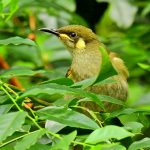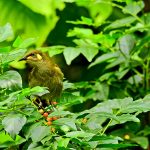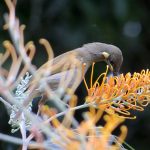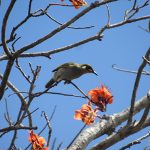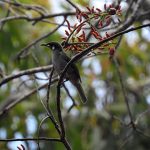YELLOW-SPOTTED HONEYEATER
The Yellow-spotted Honeyeater is a medium-sized bird, typically around 18 to 20 centimetres in length. It sports a mostly olive-brown plumage that blends seamlessly with the lush foliage of its habitat. As its name suggests, it features distinctive yellow spots or patches near its ears, which stand out against its otherwise muted colours. Its eyes are a striking white, adding an element of charm to its appearance.
This honeyeater is predominantly found in the tropical rainforests of North Queensland in extreme north-eastern Australia, between Mackay and northern Cape York Peninsula. It thrives in the dense, humid environments where the canopy is thick, and the air is rich with the scent of earth and vegetation. These forests offer the perfect backdrop for the Yellow-spotted Honeyeater’s lifestyle, providing ample food and shelter
The Yellow-spotted Honeyeater is known for its melodious calls, which are a series of clear, ringing notes. Its vocalisations are often heard echoing through the rainforest, a symphony that contributes to the vibrant soundscape of its environment. These calls are not just for communication but also play a role in marking territory and attracting mates. Despite its vibrant calls, the Yellow-spotted Honeyeater can be quite elusive and difficult to spot among the dense foliage.
As a honeyeater, this bird primarily feeds on nectar, which it gathers from a variety of flowering plants. It plays an important role in pollination, transferring pollen as it moves from flower to flower. . Its role in pollination is crucial, as it helps maintain the health and diversity of rainforest ecosystems. Additionally, the Yellow-spotted Honeyeater supplements its diet with insects and other small invertebrates, providing a balanced intake of nutrients.
The breeding season for the Yellow-spotted Honeyeater typically occurs during the warmer months, when food is abundant. The female builds a delicate cup-shaped nest, usually positioned in a tree fork or among dense foliage. The nest is constructed from twigs, leaves, and other plant materials, lined with softer substances for comfort. She lays two to three eggs, which are incubated for about two weeks before hatching.
While specific data on the lifespan of the Yellow-spotted Honeyeater is limited, honeyeaters generally live for several years in the wild, depending on environmental conditions and predation pressures.
Currently, the Yellow-spotted Honeyeater is not considered to be at risk, and it is listed as a species of Least Concern on the IUCN Red List. However, like many rainforest inhabitants, it faces potential threats from habitat destruction and climate change, which could impact its natural environment.
The Yellow-spotted Honeyeater is a vital and vibrant part of Australia’s rainforest ecosystems. Its presence underscores the importance of conserving these rich habitats, ensuring that the songs and colours of the rainforest continue to flourish for generations to come.

